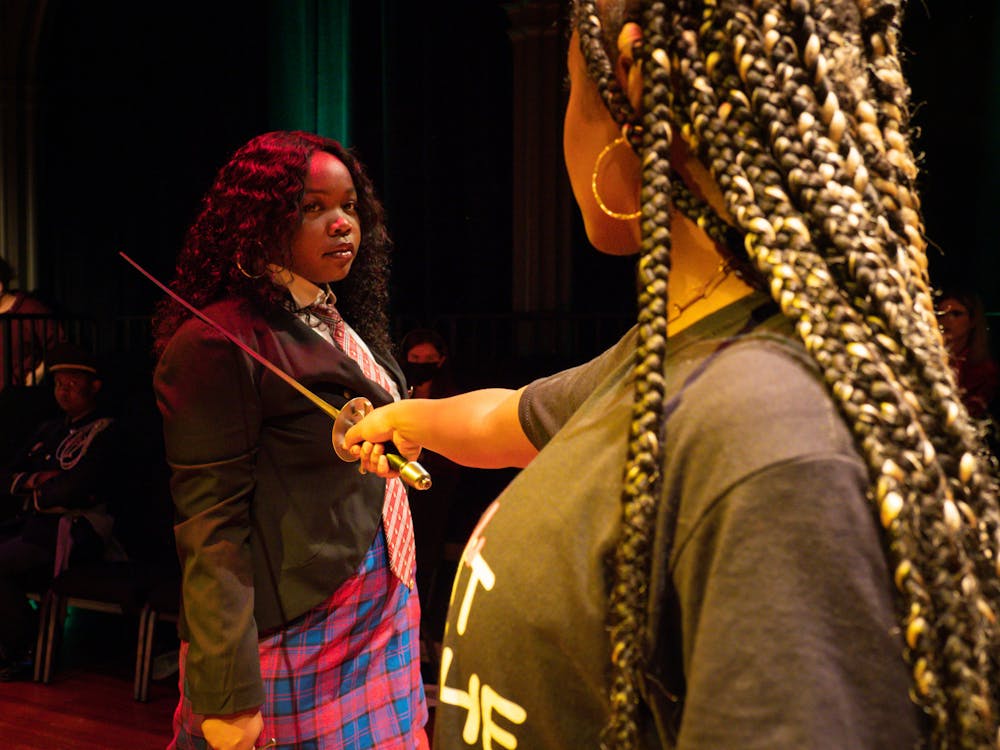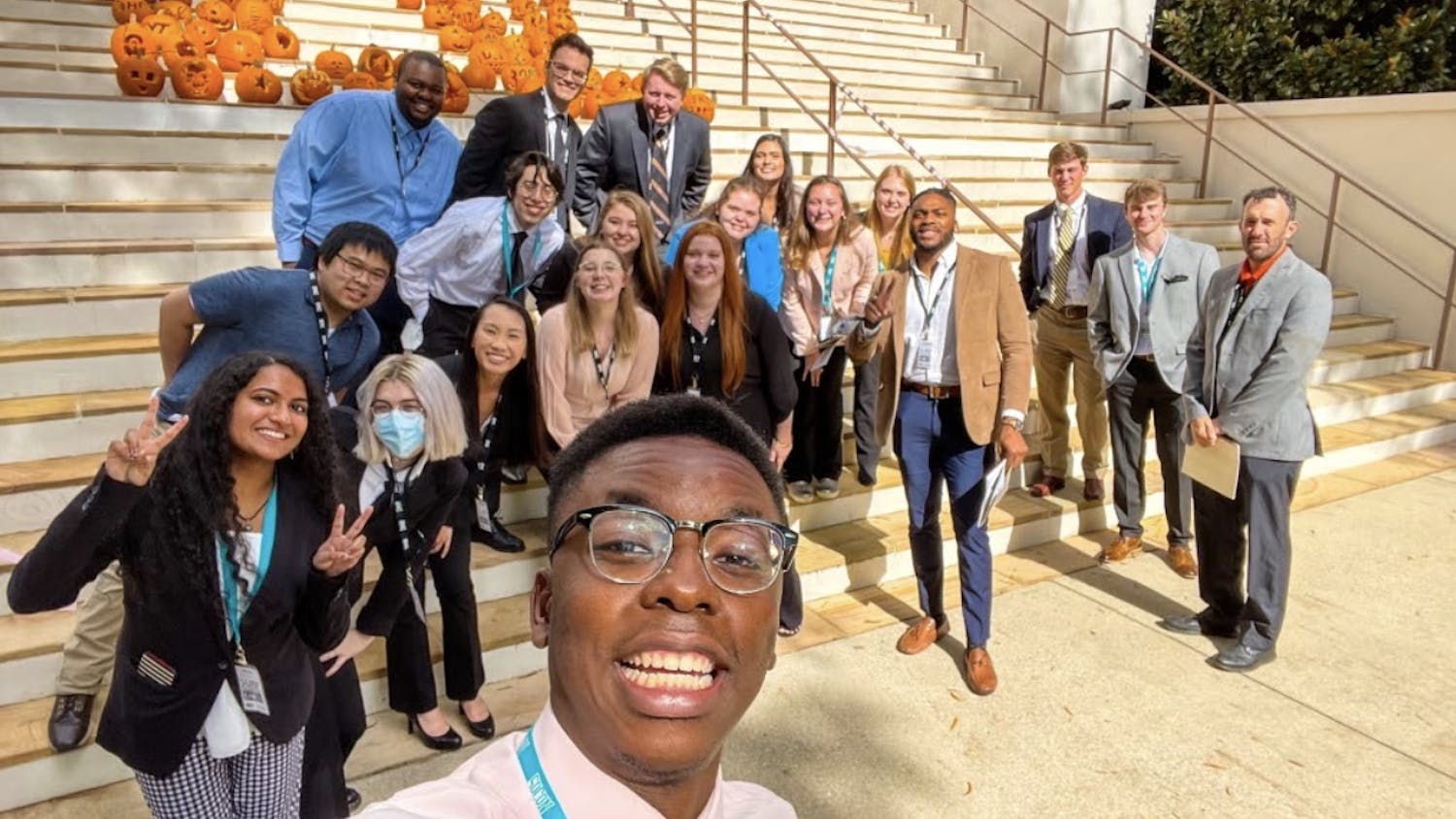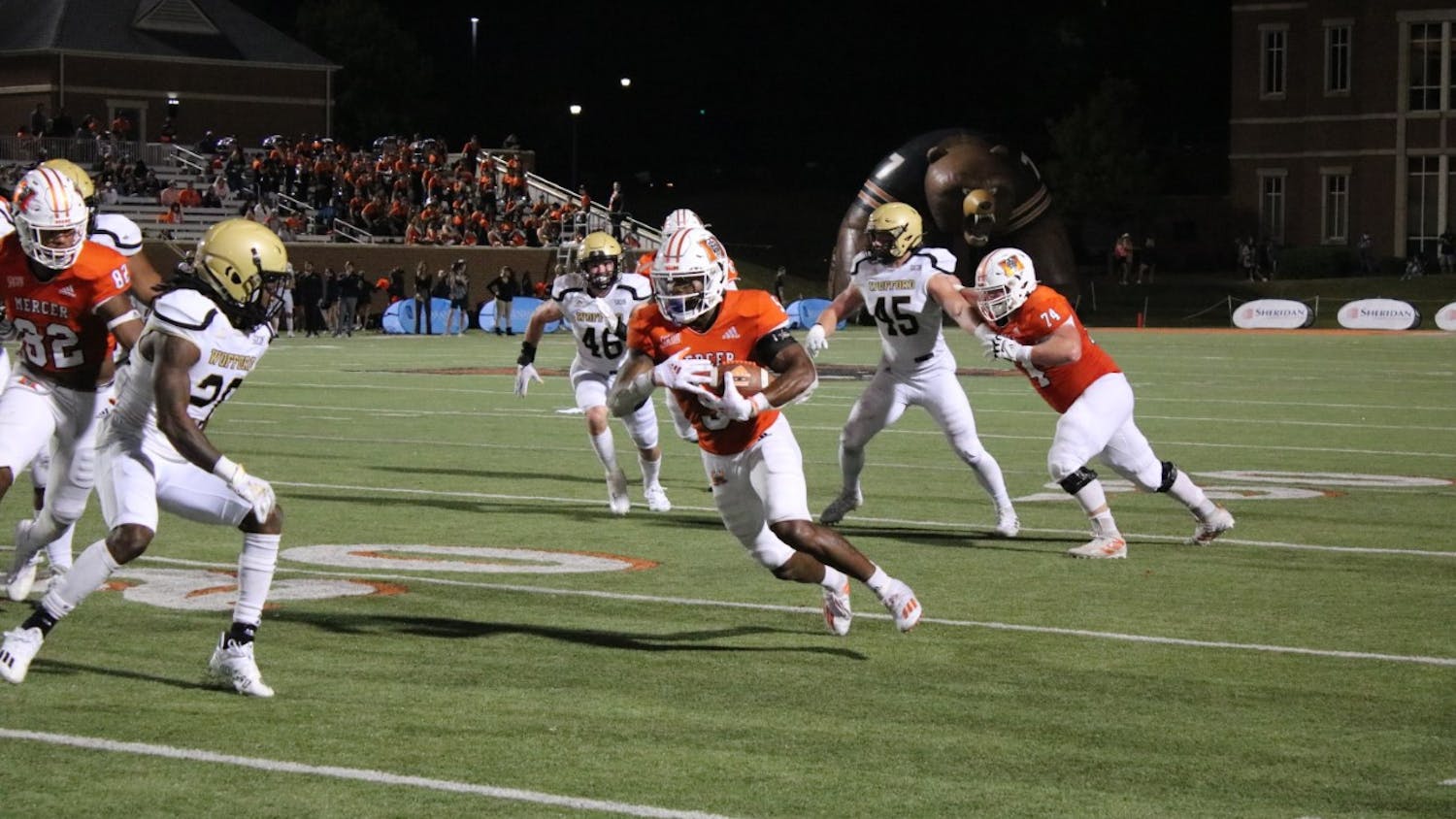Mercer Theatre performed a reimagined version of the Shakespearean classic Hamlet through the perspective of a Black American during 2020.
The production used all of the Shakespearean language, but established its message through casting and the inclusion of other elements on the stage, including a radio.
Directed by Mercer alumnus Charlie Thomas, the show featured junior Imira Ackerson as Hamlet.
All of the performances were phenomenal. The main cast consisted of Ackerson as Hamlet, junior Derrick Buie as the King (credited as the Ghost), freshman Nyah Morah as Queen Gertrude, sophomore Luke Walker as Claudius, senior Celinna A. Riordan as Polonius, freshman Caylyn Kelly as Ophelia, freshman Olivia Scott as Laertes and freshman Janhavi Kulkarni as Horatio.

The cast of Hamlet 2020 poses for a picture. Photo by Jessica Whitley.
Ackerson did a phenomenal job of performing Hamlet’s grief and despair, along with his anger about the lack of justice for individuals like Breonna Taylor and George Floyd. She captured the Shakespearean themes amazingly, along with the introduction of the BLM movement into the play.
One scene that highlighted that theme was her monologue right after Rosencrantz (Gen Haskins) and Guildenstern (Lara Smith) arrived in Denmark. As Rosencrantz and Guildenstern asked about Hamlet’s current state, he played radio clips repeating Breonna Taylor’s name over and over right before delivering a monologue about his upset in his current situation, recontextualizing his upset into the Black experience in a passionate speech, but found by the end that his white friends had become distracted and hadn’t paid attention to it at all.
Rosencrantz and Guildenstern, both sporting costumes that appealed to social justice in regards to climate change and body autonomy, never spoke about the issues, which in of itself was a commentary. They didn’t understand Hamlet and were often directed by Claudius instead.
Haskins and Smith portrayed Rosencrantz and Guildenstern as delightfully extravagant, however, and they were both very funny to watch, especially their reactions and behavior in the background.
Serving as a foil to Hamlet’s two friends was his other friend Horatio, who gave an amazing performance as well. While Horatio is very often cast as the typical man in comparison to the other characters’ eccentricities, Kulkarni did a wonderful job of portraying his friendship with Hamlet and his concern of the events going on throughout the play. Kulkarni and Ackerson’s portrayal of Horatio and Hamlet’s friendship was incredibly sweet, especially in comparison to his former friends.
Morah and Walker as Getrude and Claudius were amazing to watch as well. Morah showed a conflicted queen, torn between anger, confusion and guilt. Even when she did not have many lines in a scene, she made it clear what Gertrude was feeling just by body language. This was best demonstrated in the scene where Hamlet had the players perform a play to test Claudius’ guilt. The discomfort in her face and unease around her husband and her son were clear as the scene progressed.
Walker delivered a menacing performance as Claudius, especially as things began to spiral out of control as Hamlet’s madness progressed. The play steadily built his anger and lack of authority in the situation throughout. The scene where he was praying was excellent, especially because of the inclusion of the King’s Ghost.
The Ghost, played by Buie, was an intimidating figure, with no lines in most of his scenes. He was included in more scenes than in the original, such as towards the end of Claudius’ prayer scene, one of Hamlet’s monologues and the end of Gertrude’s scene in her chambers, where he almost seemed a representative of the characters’ individual guilt or regret.
Polonius, Laertes and Ophelia also performed well. Riordan made Polonius delightfully obnoxious and it was a joy to watch her on stage. She, like Haskins and Smith, provided a levity to the play in the first half and all made their characters memorable by making them much more comical. It was Polonius’s death right after the end of the intermission that marked the segue way Kulkarni into the more tragic aspects of the play.
Scott’s Laertes was absent for a large part of the middle, but returned after his father’s death to find his family in shambles. His fight with Hamlet was amazing and choreographer Scot Mann did a wonderful job with it, as did Ackerson and Scott performing it.
Ophelia was an immensely tragic character and Kelly did a great performance in the first half, especially in how she was used as basically a pawn by her father and Claudius against Hamlet. However, it was the second half of the play where Kelly absolutely shined as Ophelia broke down over her father’s death and descended into madness.
The rest of the ensemble did an amazing job as well, with Angelina Christine, Lauryn Green and Shayla Swanson having incredibly funny performances. The three were part of the ensemble, but had roles as one of the gravediggers/Marcellus/player, player king and player queen, respectively.
While Christine’s performance fit the tone of the show and remained funny at different parts, Green and Swanson’s performances during the play were outlandishly funny, which helped contrast the far more serious consideration as Hamlet aims to figure out Claudius’ guilt. The contrasting tones helped heighten the tension while slowly segueing into the more serious part of the play.
While the production was almost entirely the original Shakespearean dialogue, it did an excellent job of combining the Shakespearean experience with the Black experience in 2020. The radio on the stage was used several times, but two of the most prominent uses were the repeated mention of Breonna Taylor’s name in one scene and a radio piece about George Floyd in another.
Hamlet originally entered the play with two friends and carrying protest signs. For a large duration of the play, Ackerson wore a shirt with “I can’t breathe” on it and then switched into an almost identical shirt saying “I still can’t breathe” later in the production, clearly referencing George Floyd.
Along with these elements, it was choice in cast that helped nail it, brutally highlighting different power dynamics between characters. While clearly intentional to a point, I can’t say for sure exactly which characters were intentional and which weren’t, but all contributed to it. Ranging from the white Claudius killing the Black King for the crown to the white Polonius’s treatment of his Black daughter and the aforementioned Rosencrantz and Guildenstern scene with Hamlet, the characters added another layer to the production and the theme the play’s conveys.
The show also added a surprising layer of interactivity for the audience. The stage was set up so that the audience was on either side of it with the actors in the middle, putting the audience far more into the show. Before the beginning of the show, you were able to interact and talk to some of the actors.
Even during the show, there was a very minor level of interactivity, where Polonius handed one of the audience members something and then Rosencrantz and Guildenstern asked an audience member something. It was not a very prominent feature of the show, but it is a fun one.
The show was phenomenal, with not enough to be said about the actors and their performances or the directing of the show. Everyone delivered amazing performances, ranging from hilarious to menacing to tragic for whatever their character needs to be, and the message was clearly conveyed and made its point well.
Overall, this was a performance you did not want to miss. But, if you did, keep up with Mercer’s Theatre department for future events and programs this season.





